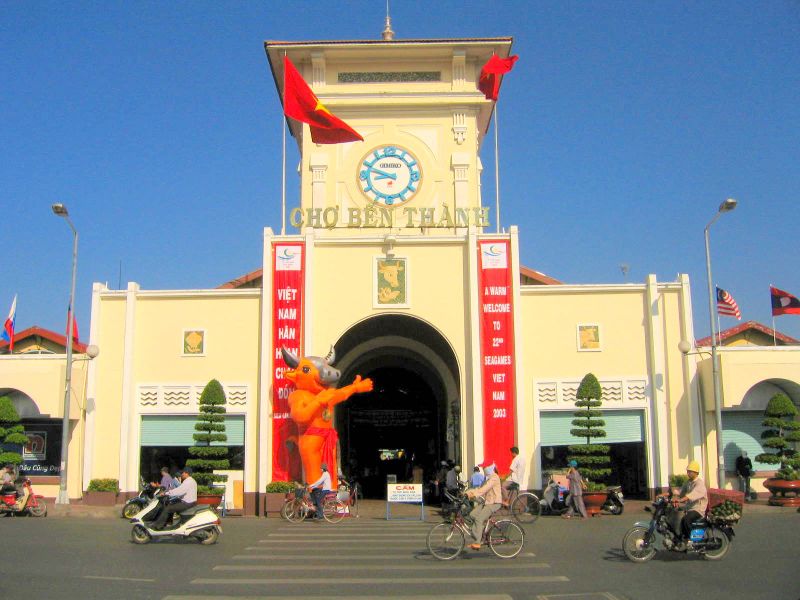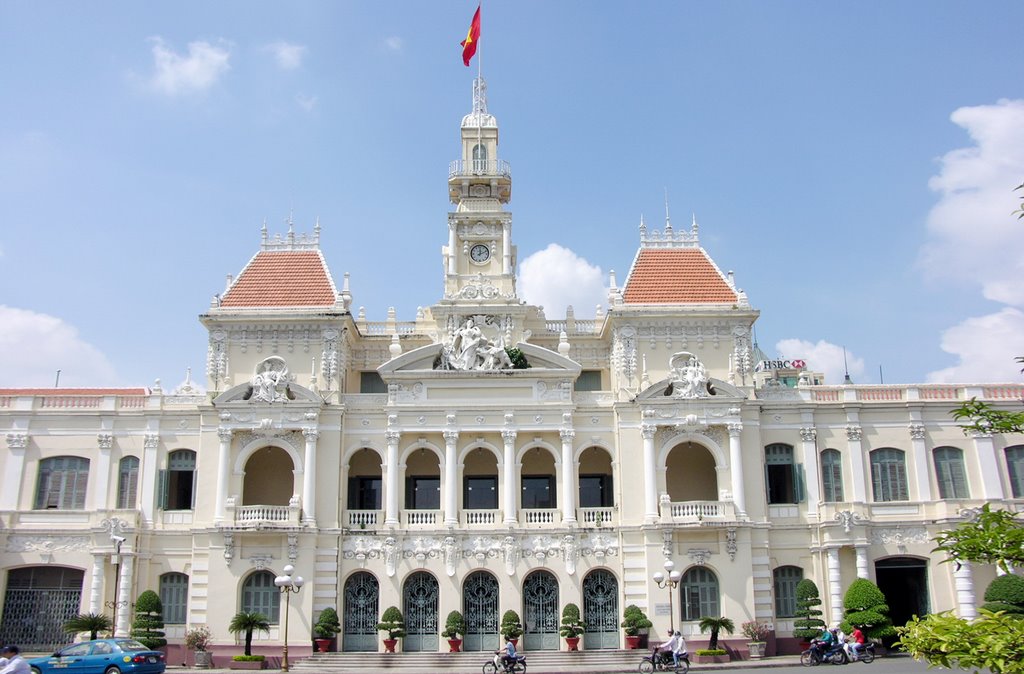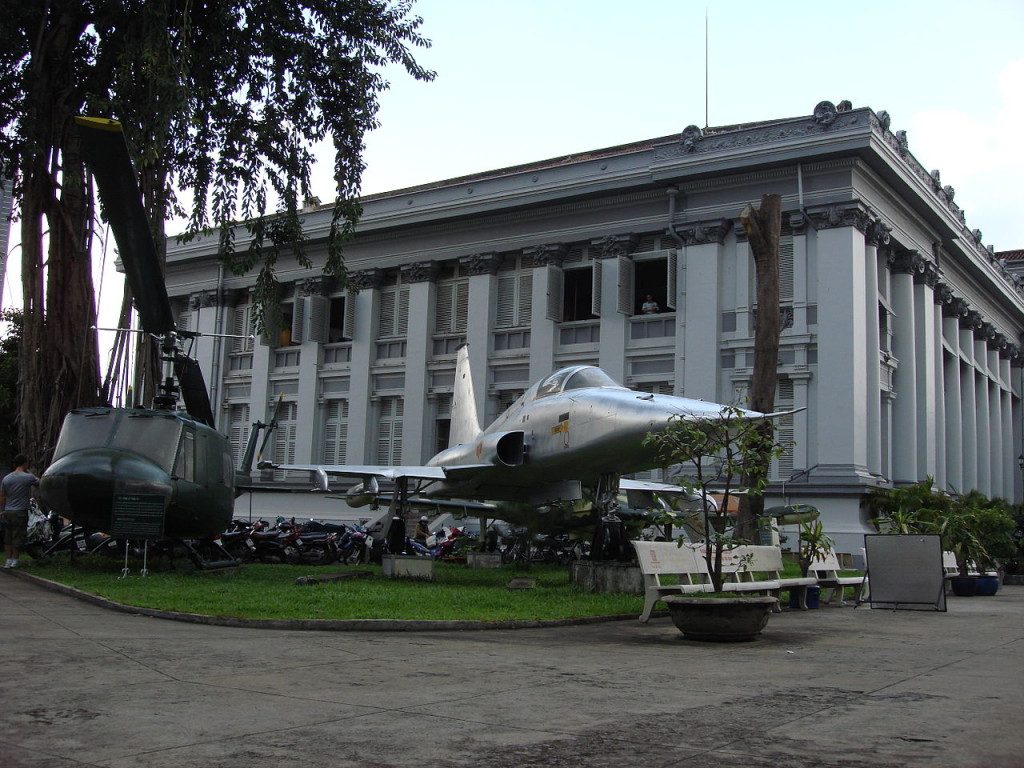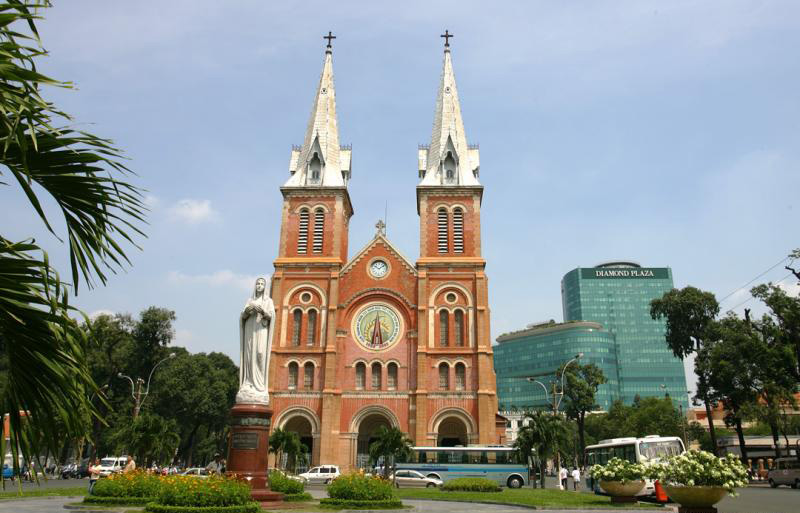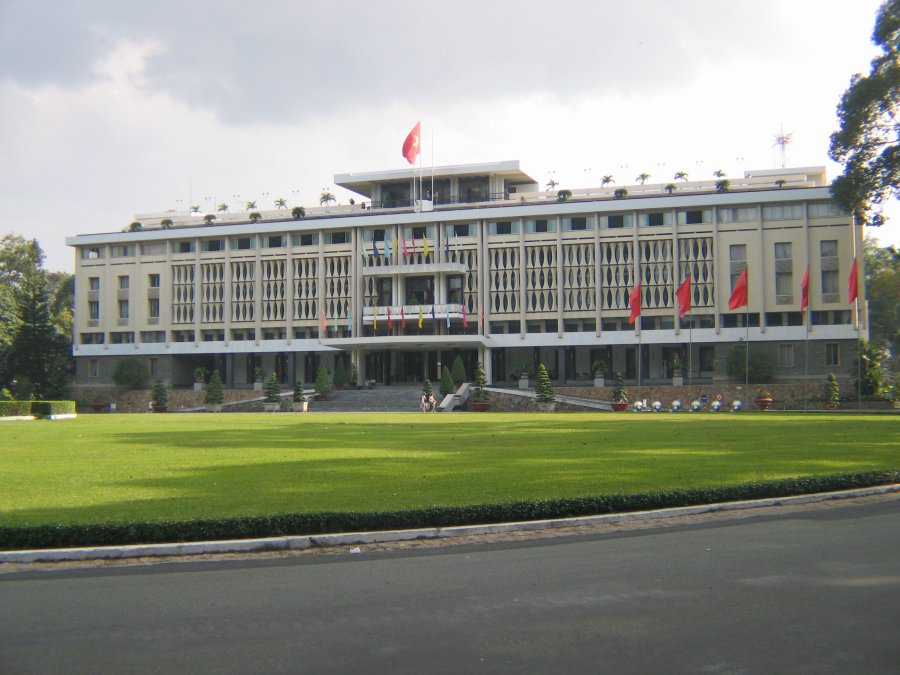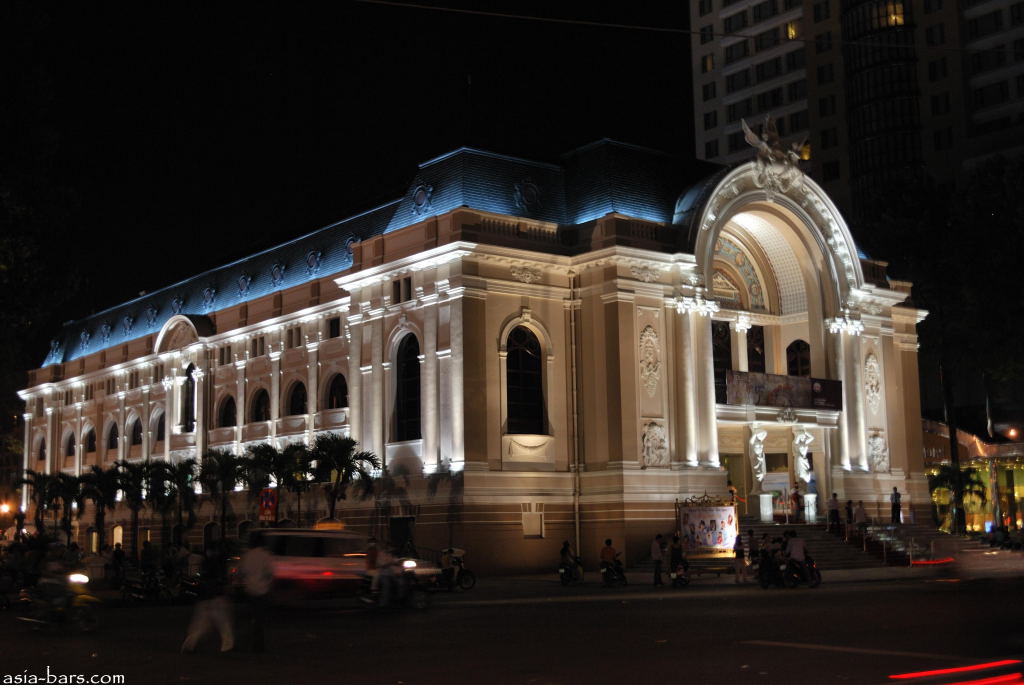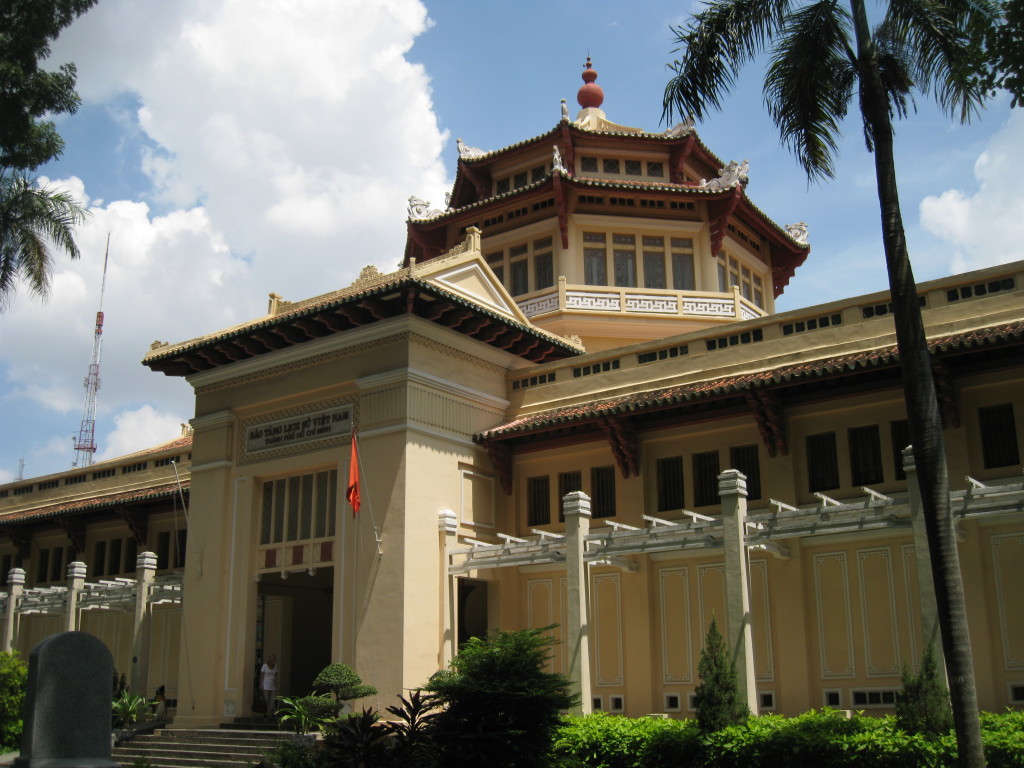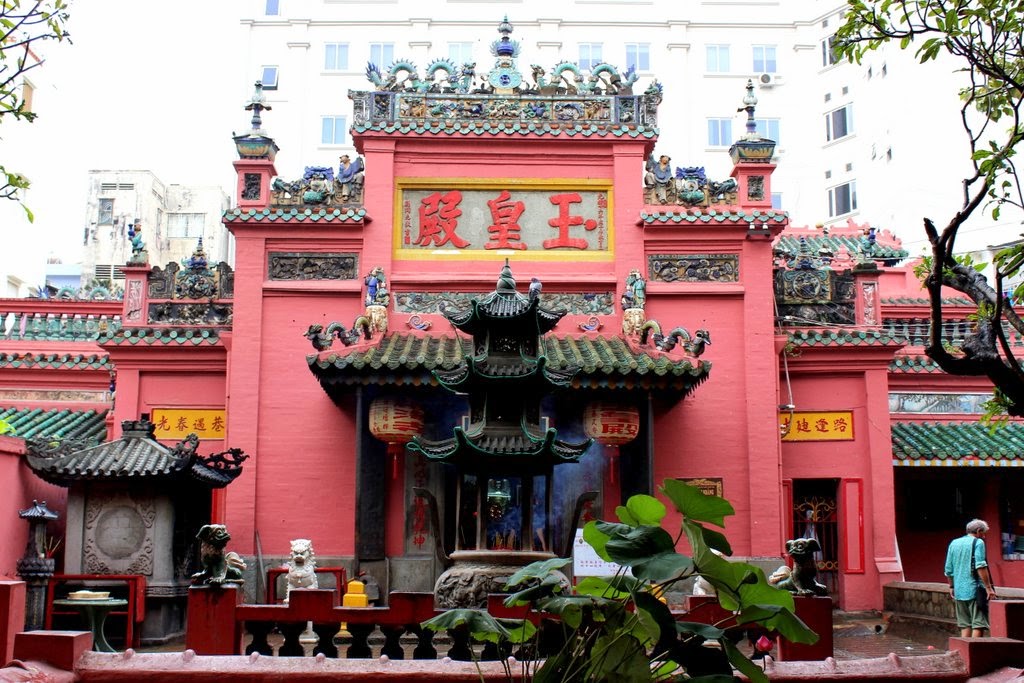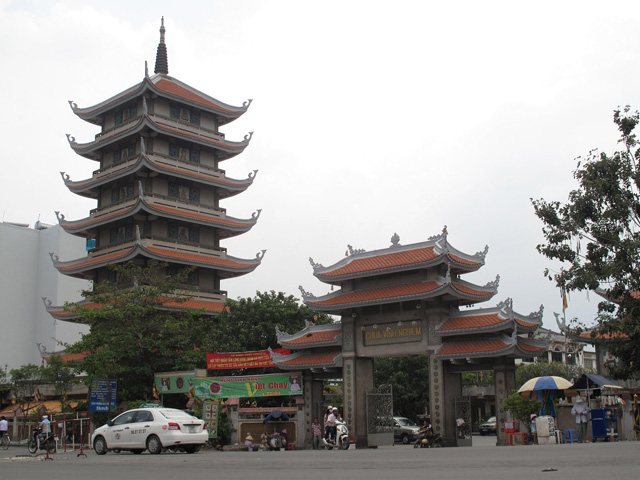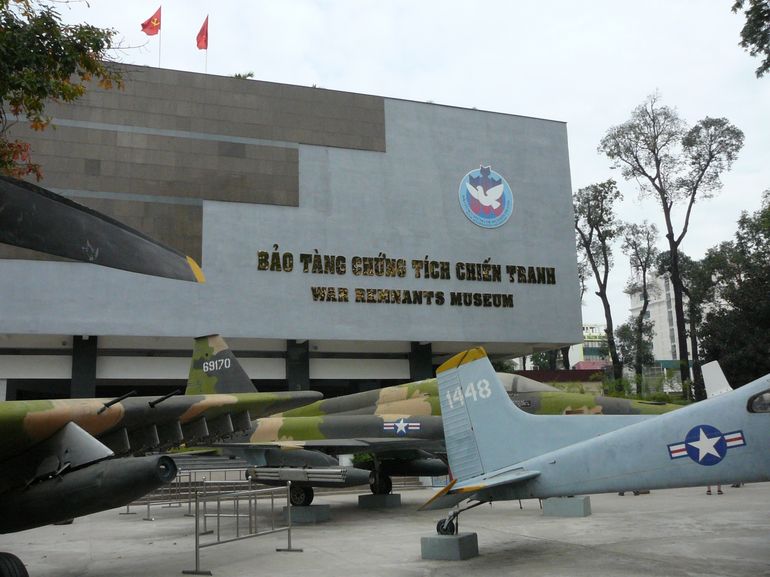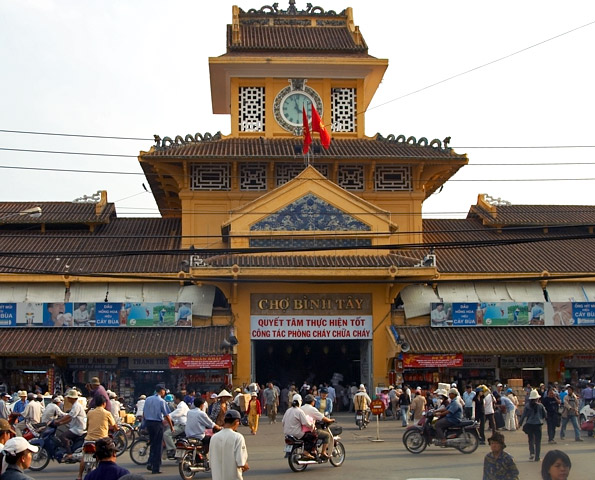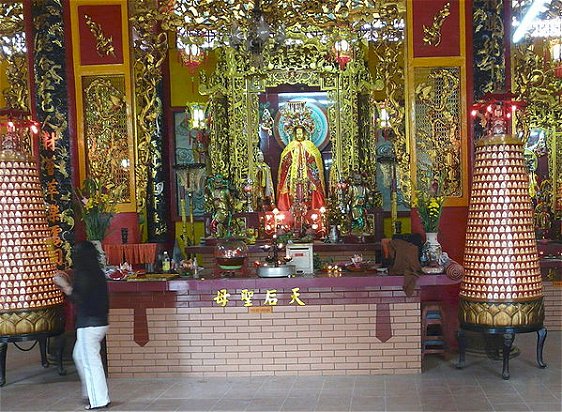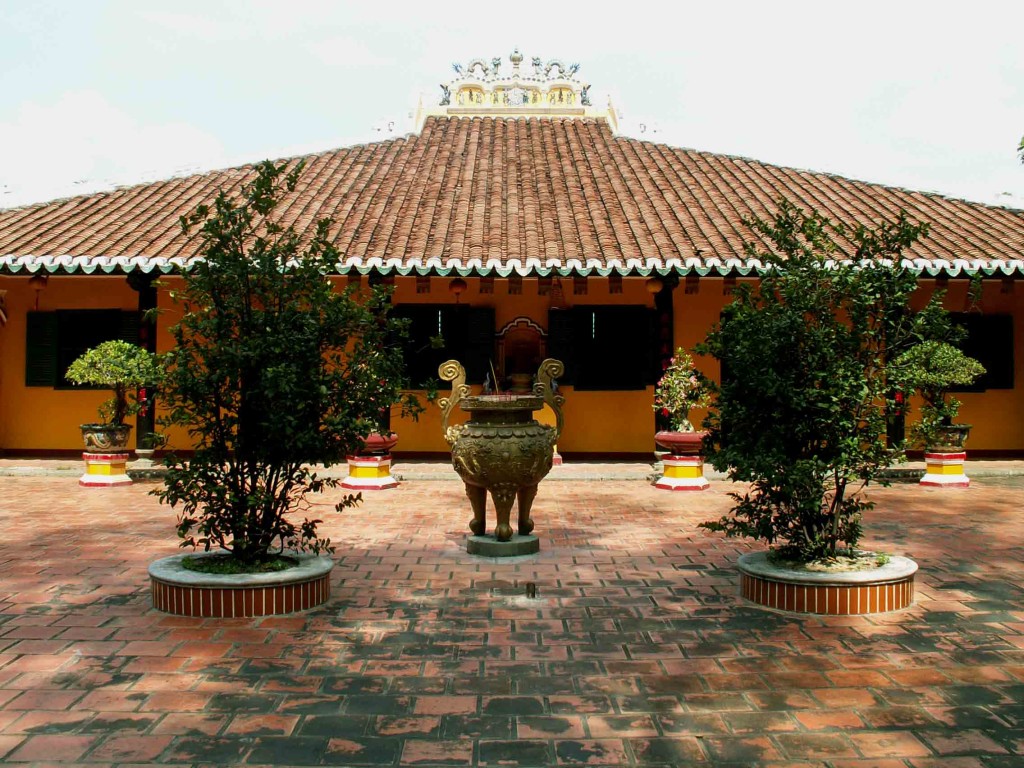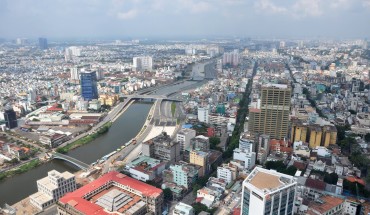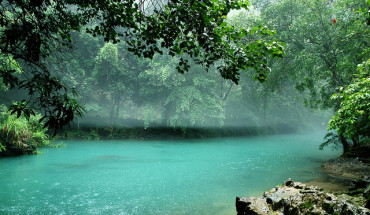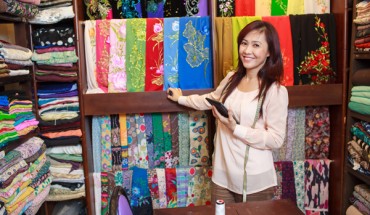The museums and attractions of Ho Chi Minh City are mostly in the downtown areas of districts 1 and 3. And although the museums are interesting, the bustling city itself is the major attraction here.
Attractions In District 1
Ben Thanh Market The clock tower over the main entrance to what was formerly known as Les Hailes Centrale is the symbol of Ho Chi Minh city, and the market might as well be, too. Opened first in 1914, it’s crowded, a boon for pickpockets with its narrow, one-way aisles, and loaded with people clamoring to sell you cheap goods (T-shirts, aluminum wares, silk, bamboo, and lacquer) and postcards. There are so many people calling out to you that you’ll feel like the belle of the ball or a wallet with legs. Watch for pickpockets. Out front, near the main entrance, find lots of knockoff brand-name clothes, and farther in is a number of small souvenir stands. Toward the back are a few small cafes serving local cuisine or coffee and che, a popular Vietnamese dessert. The wet market at the far back, with its selection of meat, fish, produce, and flowers, is interesting and hassle free; no one will foist a fish on you. The market has cleaned itself up for the tourists over the years, which is a shame because the added hygiene comes at the cost of the market’s old charm and raw authenticity. In open-air stalls surrounding the market are some nice little eateries that open just as the market itself starts closing down, and this is, in fact, one of the best place to try authentic local cuisine. The adventurous can sample good local specialties like rice dishes, noodle soup, bun dishes of vermicelli noodles, or ice cream and dessert for next to nothing.
Note: If you start from Ben Thanh Market and take a walk up Le Loi Street (the main east-west avenue) toward central Dong Khoi, you’ll stroll past loads of tourist shops with souvenirs, booksellers with photocopy knockoffs on the street, watch-repair shops, camera stores, and T-shirt shops. As good as maybe even better than the sprawling market.
City Hall and Nguyen Hue Plaza Ho Chi Minh’s city hall was originally a French hotel constructed between 1902 and 1908, a fantastic ornate example of refined colonial architecture. Unfortunately, it’s not open to the public, but there is a small walking mall out front and running the length of the behemoth Rex Hotel, itself an important vestige of the American years when it housed the CIA headquarters. The park is a great spot for a good group photo with the majestic City Hall in the background, and the people- watching here is supreme (though you’re likely to be the people that are being watched).
Ho Chi Minh City Museum Formerly the Revolutionary Museum, this central behemoth attracts more newlyweds posing for photos on the front steps than anything. Originally built in 1890 by the French as a commercial museum, then a Governor’s Palace, and later committee building, the exhibits in this museum cover a broad range, from archaeology to ethnic survey, early photos of the city, and documents from its founding in the 1600s. The second floor is heavy on Vietnam’s ongoing revolution, with displays of weaponry and memorabilia from the period of struggle against imperialism and many flags, placards, and dispatches from the rise of Communism, beginning with the August Revolution of 1945 all the way to the fall of Saigon. The bias is heavy, of course, and it is an important rendering of Vietnam’s protracted struggle and ideologies, but it is interesting to note how the displays, not unlike socialist ideals, are a bit frayed around the edges in a land that is going pell-mell toward a market economy. The grounds are picturesque, thus the young couples posing for wedding photos, and there is an interesting collection of captured U. S. fighter planes, tanks, and artillery in the main courtyard. Underneath the building is a series of tunnels (closed to the public) leading to the Reunification Palace, once used by former President Ngo Dinh Diem as a hide-out before his execution in 1962.
Ho Chi Minh Museum This large museum commemorates the man this city was named for. The museum is in the “Dragon House (Nha Long) Wharf” a 19th-century building with a European design and stylish Chinese-style roof from which it takes its name. The location is auspicious because this is where the young Ho Chi Minh (then Nguyen Tat Thanh) left to sail for Europe. The museum tells the rags-to-equality story of a self-made revolutionary, but mostly in Vietnamese. The relics of Ho’s life are many, and much can be gleaned from photos and what English descriptions you can find. The museum is south of town, just across a small canal off the Saigon River in District 4.
Notre Dame Cathedral The neo-Romanesque cathedral was constructed between 1877 and 1883 using bricks from Marseilles and stained-glass windows from Chartres. The Romanesque towers of nearly 60m (197 ft.) loom over a large white statue of the Virgin Mary and the nearby Ho Chi Minh Post Office. The cathedral would pretty much be at home in any Catholic European country. The tiles are a cubic pattern done in black, white, and gray. They have a slightly disconcerting 3-D effect, but they are no match for the statue of Mary framed in neon blue lights in the first archway on your left. The atmosphere is fairly serene, and there’s something calming about taking a rest on the wooden pews.
Reunification Palace Designed as the home of former President Ngo Dinh Diem, the U. S. -backed leader of Vietnam until his assassination in 1962, this building is most notable for its symbolic role in the fall of Saigon in April 1975, when its gates were breached by North Vietnamese tanks and the victor’s flag hung on the balcony; the very tanks that crashed through the gates are enshrined in the entryway, and photos and accounts of their drivers are on display. Built on the site of the French governor general’s home, called the Norodom Palace, the current modern building, designed when modern meant “sterile, ” was completed in 1966 it looks something like an old elementary school to my eye now, but modern-design fans love it. Like the Bao Dai Palace in Dalat, the Reunification Palace is a series of rather empty rooms that are nevertheless interesting because they specialize in period kitsch and haven’t been gussied up too much. Tour private quarters, dining rooms, entertainment lounges, and the president’s office that feel like everybody just up and left one day (they did) a tour is almost eerie, really. Most interesting is the war command room, with its huge maps and old communications equipment, as well as the basement labyrinth. There is an ongoing screening in a series of rooms in the basement mercifully cool and a good rest while touring of mostly propaganda about the war years (plays in French, English, Japanese, and Chinese in separate screening rooms).
The Conference Hall in the main room is still used for important national events. The carpeting you’ll see on your visit is a shabby piece of cheap cloth used for display and protection purposes only. For special events, like the recent APEC summit and the signing of the WTO accord, the display rug is whisked away and the “for guests only” carpet, a plush, bright red piece with gold accents, is unveiled.
Saigon Opera House (Ho Chi Minh Municipal Theater) This magnificentbuilding was built at the turn of the 20th century as a classical opera house to entertain French colonists. The building was renovated in the 1940s, only to be badly damaged by bombers in 1944. A shelter for refugees after the Geneva Accord split the country at the 17th Parallel in 1954, the building would briefly house the parliament before falling under first private and, ultimately, state hands (after reunification) as an opera house and theater. There have been extensive renovations in recent years. The three-story interior houses some 1, 800 seats. Today the Municipal Theater does very little in terms of performances, but it is a stalwart atmospheric holdout amid the rising steel-and-glass downtown.
At the intersection of Le Loi and Dong Khoi street.
Vietnam History Museum House in a rambling concrete pagoda like structure, the museum presents a clear picture of Vietnamese history, with a focus on the south. There’s an excellent selection of Cham sculpture and the best collection of ancient ceramics in Vietnam, although some of the artifacts are being held together by Scotch tape. Weaponry from the 14th century onward is on display; one yard is nothing but cannons. Room 4 (left of the main entrance) has a fascinating, slightly creepy display of an embalmed body in remarkable shape that dates back to 1869. One wing is dedicated to ethnic minorities of the south, including photographs, costumes, and household implements. Nguyen dynasty (1700-1945) clothing and house wares are also on display. There are archaeological artifacts from prehistoric Saigon. Its 19th- and early-20th-century histories are shown using photos and, curiously, a female corpse unearthed as construction teams broke ground for a recent housing project. There are even some general background explanations in English, something missing from most Vietnamese museums.
A small three-row theater inside the museum shows regular water puppet performances. It’s an intimate venue, and the performance is more clever and witty than the for-the-tourists water puppet show in Hanoi.Performances is held every hour between 9 and 11am and 2 and 4pm Tuesday through Sunday.
Also adjacent to the History Museum is the Ho Chi Minh City Campaign Museum, the first address on Le Duan Street, which originates just across from the entrance to the botanical garden and zoo. In the large courtyard outside the museum, you’ll find another collection of war detritus similar to what you’ll see at the War Remnants Museum and the Ho Chi Minh City Museum, but here you can see the crumpled remains of an American reconnaissance plane shot down, as well as more utilitarian vehicles, troop carriers, and the construction equipment from the U. S. defoliation campaign. The museum has little in the way of English explanations it’s more or less a place for Vietnamese school Held trips (there’s a long block of classrooms attached) but Vietnam War enthusiasts can find some weaponry and tools not displayed in other museums in town
Attraction in district 3
Emperor Jade Pagoda (Phuoc Hai) One of the most interesting pagodas in Vietnam, the Emperor Jade is filled with smoky incense and fantastic carved figurines. It was built by the Cantonese community around the turn of the 20th century and is still buzzing with worshipers, many lounging in the front gardens. Take a moment to look at the elaborate statuary on the pagoda’s roof. The dominant figure in the main hall is the Jade Emperor himself; referred to as the “god of the heavens,” the emperor decides who will enter and who will be refused. He looks an awful lot like Confucius, only meaner In an anteroom to the left, you’ll find Kim Hua, a goddess of fertility, and the King of Hell in another corner with his minions, who undoubtedly gets those the Jade Emperor rejects. It’s spooky.
The Hoa Binh Noodle Shop The name means “Peace Noodles” and this little shop is no different from the many others in town, except for a small red plaque above the entrance and a flag of the Communist regime. The plaque, written in Vietnamese, marks this discreet little storefront’s important place in history. Its upstairs floors were the staging ground of the Tet Offensive of 1968, a surprise attack on U. S. forces region-wide during a cease-fire that, with thousands of losses, was tantamount to the Viet Cong throwing themselves on their collective sword. However, with the incursions reaching as far as the U. S. Embassy in Saigon, as well as at points throughout the city, this was a turning point in the conflict; it changed popular opinion in the United States and among troops stationed in Vietnam, creating a major diversion from later intensified fighting on northern fronts. Eighty-eight-year-old Ngo Toai, the shop owner, was the Madame Lafarge of the offensive, serving noodles by day and hosting high-level Viet Cong planners by night. The raid blew his cover, and Mr. Toai spent the rest of the war in jail, only to return to his shop in 1975 and pick up the ladle right where he left it, never once betraying the revolutionary zeal that made him a place in history. If you’re lucky, you’ll meet the genial Mr. Toai during your visit; if not, his sons will serve you up some good noodles and hand you their ready-made packet of information about their father, complete with photos from the war days as well as ones taken with the many tourists who visit, and a few articles from international papers. The noodles are pretty good, too. Often visited in conjunction with Vinh Nghiem Pagoda.
Vinh Nghiem Pagoda Located to the north of town on the road to the airport, this pagoda is distinct because of its constant activities at the attached school, as well as for the daily workings of the many monks and nuns housed here. I visited when the place was in preparation for a funeral, and it was like the set of a Hollywood movie, complete with egoistic flower coordinators and a bevy of fawning assistants. Housed under large, sloping Chinese-style roofs, with upturned cornices, the temple has two floors, with a grand sanctuary on the second floor (often closed to visitors) and a more utilitarian hall on the ground floor, as well as large block of classrooms and housing for monks and; nuns, some of whom may come out and greet you in the hopes of practicing their English. A visit here is popular in conjunction with the Hoa Binh Noodle Shop.
Near Vinh Nghiem in District 3, you’ll also find the brash pink facade of the wedding cake that is Tan Dinh Cathedral, a busy working Catholic church with daily services that stands out like a sore thumb (or a pink elephant) in the busy Saigon streetscape of the Tan Dinh area. The nearby Tan Dinh Market is notable for the absence of foreign visitors and the pushy hard sell going on in the popular Ben Thanh Market; Tan Dinh is a good glimpse at the workings of an average city market, with cloth sellers at the front, dry-goods vendors in the center, and meats, vegetables, and fish sold in the back.
War Remnants Museum The War Remnants Museum is a comprehensive collection of the machinery, weapons, photos, and documentation of Vietnam’s wars with the both the French and Americans (though the emphasis is heavily on the latter). The museum was once called the War Crimes Museum, which should give you an idea of whose side of the story is being told here. Short of being outright recrimination, this museum is a call for peace and a hope that history is not repeated visitors are even asked to sign a petition against the kind of aerial carpet-bombing that so devastated the people of Vietnam. The exhibit begins to the right of the entrance with a room listing war facts: troop numbers, bomb tonnage, and statistics on international involvement in the conflict, and numbers of casualties on both sides. Next is a room dedicated to the journalists who were lost during the war. The exhibits are constantly evolving, and the museum is currently expanding and modernizing, improving its presentation and explanations throughout. One room is devoted to biological warfare, another to weaponry, and another to worldwide demonstrations for peace. The explanations, which include English translations, are very thorough. There is a large collection of bombs, planes, tanks, and war machinery in the main courtyard. Kids will love it, but you might want to think twice before taking them inside to see things like wall-size photos of the My Lai massacre and the bottled deformed fetus supposedly damaged by Agent Orange. There’s also a model of the French colonial prisons, called the Tiger Cages, on the grounds.
Attractions In District 5
Cholon (“Chinatown” of Ho Chi Minh City) Cholon is a sizable district bordered by Hung Vuong to the north, Nguyen Van Cu to the east, the Ben Nghe Chanel to the south, and Nguyen Thi Nho to the west. Cholon is the predominately Chinese district of Saigon and probably the largest Chinatown in the world. Cholon exists in many ways as a city quite apart from Saigon. The Chinese began to settle the area in the early 1900s and never quite assimilated with the rest of Saigon, which causes a bit of resentment among the greater Vietnamese community. You’ll sense the different environment immediately, and not only because of the Chinese-language signs. Cholon is where you might have found dark, exotic opium dens and brothels in the French colonial time, the same opium dens and brothels that greeted American troops. Story has it that a huge number of U. S. troops went AWOL in Cholon during the war when the fall of Saigon was imminent, U. S. expeditionary forces advertised a period of amnesty for U. S. citizens on the lamb in the district only one dazed and confused soldier came stumbling out.
6 A bustling commercial center, Cholon is a fascinating maze of temples, restaurants, jade ornaments, and medicine shops. Gone, however, are the brothels and opium dens of earlier days. You can lose yourself walking the narrow streets, but it makes sense to take a cyclo by the hour to see the sights. Many of the city tours (see “Visitor Information & Tours, ” earlier in the chapter) start at Giac Lam Pagoda and make a few stops in the district, including the large market.
If on your own, start with a motorbike or taxi ride to the Binh Tay Market on Phan Van Khoe Street, which is even more crowded than Ben Thanh and has much the same goods, but with a Chinese flavor. There’s much more produce, along with medicines, spices, and cooking utensils, and you’ll find plenty of hapless ducks and chickens tied in heaps. From Binh Tay, head up to Nguyen Trai, the district’s main artery, to sec some of the major temples on or around it. Be sure to see Quan Am, on Lao Tu Street off Luong Nhu Hoc, for its ornate exterior. Back on Nguyen Trai, Thien Hau pagoda is dedicated to the goddess of the sea and was popular with seafarers making thanks for their safe trip from China to Vietnam. Finally, as you follow Nguyen Trai Street past Ly Thuong Kiet, you’ll see the Cholon Mosque, the one indication of Cholon’s small Muslim community. Other sites in Cholon include the following:
Chua Quan Am Temple (12 Laoth St. ) is a classic Chinese temple wafting with incense, blaring with music meant to soothe and speak of mountains but crackling speakers at high decibels mean different things to different people. Nearly 20 resident monks and a cherubic abbot are on hand and welcome foreign visitors. In fact, they’ll even take the time to show you around and allow you to take photos, but the expectation is a small donation in the alms box at the altar. Buy one of the oversize incense the size of a large flashlight and make a wish for your journey (in Vietnam or in life). The temple is heavily gilded in snazzy gold and red paint, and don’t miss the cool mechanized rotating offering stands. This is a “working temple” and that means the place is busy day and night with visiting supplicants. Just outside the entrance, don’t miss the busy cabinetmakers at work in a large collective at street side.
Cha Tam is Cholon’s small Catholic cathedral, with high vaulted ceilings and surrounded by the Stations of the Cross. A statue of Mary stands in a small grotto out from and looks like a Buddhist Bodhisattva with all of the offerings, placards, and prayer entreaties at her feet. This little cathedral is a cool place to take a break and visit an imposing white statue of Jesus or a standing statue of St. Francis of Assisi. Don’t miss tin-large relief of the Last Supper.
Thien Hau The Lady Temple was originally built by a Cantonese congregation in the early 19th century. The temple pays homage to a special psychic lady, Thien Hau, born A. D. 940, who was said to be able to predict the weather and protect sailors. The classic Chinese temple has a wooden entry; small central ponds flanked by heavy, bright red pillars; and elaborate carvings of gods and monsters. The place is busy all day and echoes with sounds from the adjacent schoolhouse. The huge coils of incense hanging over the central courtyard space make for great photos.
Giac Lam Pagoda Giac Lam Pagoda, originally built in 1744 and remodeled in the early 1900s, is the oldest pagoda in Saigon. The garden in the front features the ornate tombs of venerated monks, as well as a rare bodhi tree. Next to the tree is a regular feature of Vietnamese Buddhist temples, a gleaming white statue of Quan The Am Bo Tat (Avalokitesvara, the goddess of mercy) standing on a lotus blossom, a symbol of purity. In the temple, there are just two simples rules: no hats and no smoking (though most do); wearing shoes is permitted. Inside the temple is a spooky funerary chamber, with photos of monks gone by, and a central chamber chock-full of statues. Notice the aged dark carved wood of the double-height hall. Walls are lined with funerary portraits, from large red-and-yellow plaques to small wallet-size photos, and there is some very elaborate statuary about and an altar with gilded figures. There are three altars at the back: The central is Ho Chi Minh, who is flanked by photos of the recently deceased. The monks are busy but quite friendly (when they’re not chatting on their cell phones). For a small fee, monks don yellow prayer robes over their daily temple attire and perform beautiful chanting services, accompanied by bells, for visiting supplicants, mostly to loved ones. One well-known monk ministers to the sick and suffering (and tells fortunes) in a side room. Take a look at the outside courtyard with its many tombs of long- deceased monks and stewards of the temple, and don’t miss the large outbuilding just to the right of the entrance inside are aisles of shelves with colorful urns of ashes, Chinese pots with red lights, candles, and offerings. There are lots of older gentlemen milling about, playing checkers and chewing the fat, and a big Buddha statue rests near the entry road, as well as a nearby pagoda quite new dedicated to the Buddha of Compassion. You can climb the temple for a good view of town, but the real attraction is the original wooden structure.
Extra reading at Ho Chi Minh City tours or Ho Chi Minh City hotels.


